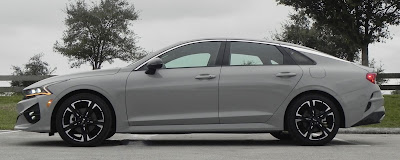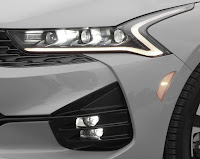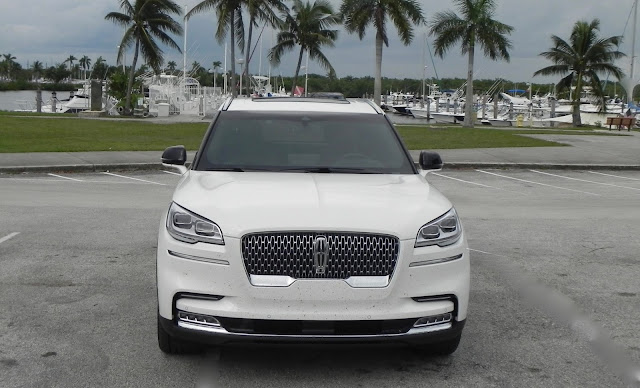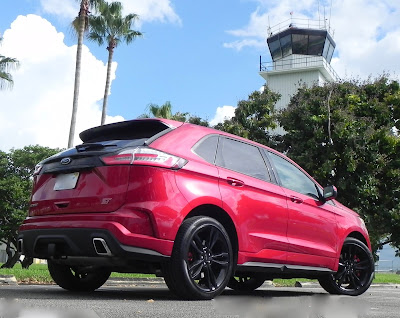KIA MOVES ON FROM OPTIMA
TO NEW K5 SEDAN FOR 2021
When it came time for Kia to update its Optima sedan after nearly 20 years of production, the South Korean automaker didn’t mess around.
The overhaul was so extensive that the old Optima is completely gone, replaced by a new vehicle, the K5, for 2021 with a major upgrade in both appearance and features from its predecessor.
The 2021Kia K5 already has had a huge impact in sales, taking over the No. 2 spot in Kia’s November report, passing the smaller Forte behind only the company’s popular Telluride SUV after just its fifth month in showrooms.
With an all new platform, the new K5 is longer, wider, lower, and, according to the company, stronger than its predecessor. It is offered in five trim levels — LX, LXS, GT-Line, EX, and GT — with two turbocharged engines depending on the trim and available all-wheel drive instead of the standard front-wheel-drive setup.
Most trims, like the GT-Line that I checked out recently, get a 1.6-liter turbo 4-banger that checks in at 180 horsepower and 195 pound-feet of torque and is mated to an 8-speed automatic transmission.
The top-of-the-food chain GT model gets a 2.5-liter turbo-4 that ups horsepower and torque numbers to 290 and 311, respectively, and is mated to a new “wet” double-clutch transmission.
Fuel mileage numbers for my GT-Line model are a solid 26 miles-per-gallon city, 34 highway, and 29 combined which puts it in the middle of the segment.
Numbers for the dual-clutch GT model are slightly less, but you have to pay some price for the 5.8-second zero-to-60 clocking Kia reports for the GT.
The K5 has a coupe-like sleek profile that does cut down on rear headroom to 37.8 inches and requires you duck your head wisely when getting in the backseat, but that also gives the K5 a classier outer appearance.
The impression that there is more to the K5 GT-Line than just a typical run-of-the-mill midsize sedan carries over to the interior, where there is amble legroom (46.1 inches in the front, 35.2 in the back) and cloth and leatherette seat trim (with the GT-Line logo) to accommodate your tush.
Yes, you will find hard plastics in the cabin, but there is also generous use of higher quality materials as well for a near-luxury feel.
The list of creature comforts on the K5 GT-Line is extensive as well. They include a tilt-and-telescoping steering column, front console with armrest and good-size storage bin, dual-zone automatic climate control, and a leather steering wheel with buttons for Bluetooth, audio, and cruise controls.
Standard technological systems include Apple CarPlay and Android Auto, second-row USB charge ports, an 8-inch touchscreen for infotainment functions, a rearview camera with dynamic guidelines, and push-button start.
Driver assistance technology and safety features include forward collision avoidance with pedestrian detection, blind-spot warning, rear cross-traffic alert, lane-keeping assist and alert, an electronic parking park with an auto-hold function, and an assortment of airbags that include full-length side-curtain airbags.
LED headlights with auto on/off, LED fog lights, heated outside mirrors with LED turn-signal alert, and LED taillights complete the standard features while also included in the $$28,0 90 starting MSRP are such items as a panoramic sunroof, wireless phon charger, heated front seats, heated steering wheel, and Smart cruise control.
That left only a couple of options for my test vehicle with special wolf gray paint and navigation with a 10.25-inch screen running the bottom line to $31,300 including the $965 destination and delivery cost.
What I liked about the 2021 Kia K5 GT-Line: The exterior has a sleek profile that gives the K5 the look of a higher class model. The infotainment system comes with a touchscreen that (with one exception noted below) is very user friendly. Most safety features are standard. Trunk capacity is a generous 16 cubic feet, which is usually confined to full-size sedans.
What I didn’t like about the 2021 Ki a GT-Line: It’s no more than a slight annoyance in the operation of infotainment features, but I still would like a knob to surf the radio dial instead of using the touchscreen.
Would I buy the 2021 Kia K5 GT-Line? Yes. It faces a lot of tough competition from its Japanese rivals and even its South Korean compadre Hyundai (which owns a 34-percent share of Kia), but it still is worth a look if you are looking for an attractive and value-laden passenger sedan.





















































